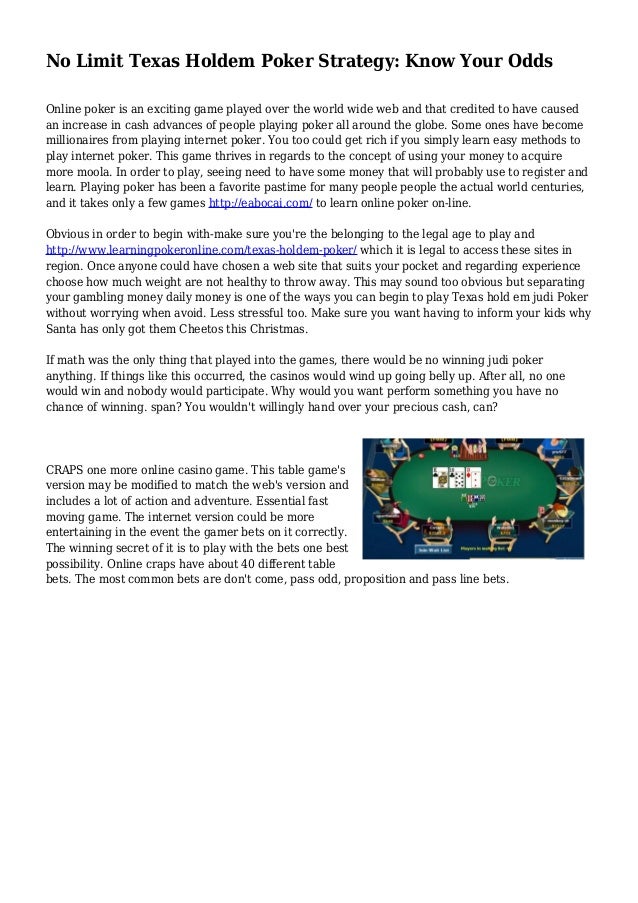No-Limit Texas Holdem Tournament Strategy Learn the most important aspects of great Texas Holdem tournament strategy from some of the game’s best professional players. Learn how to play in every level of a poker tournament, big or small, with proper balanced play and expert advice. There are essentially five key strategic areas that you will need to focus on when you play Texas Hold’em cash games. For Texas Hold'em tournament strategy, there exists a whole set of other poker tournament tips. While there are many things that add up to good poker strategy, we feel that these are the Top Five for new or intermediate players. Best Overall: Kill Phil: The Fast Track to Success in No-Limit Hold 'em Poker Tournaments. The majority of winning players do not include limping in their preflop poker strategy; unsurprisingly the majority of losing players think limping is the go-to strategy. Limping isn’t an effective approach as the small, ‘insignificant’ losses add up quickly. See our Texas Holdem strategy guide for more information on limping. Texas Hold'em No Limit (NL) Strategy Although there are different formats of Texas Hold’em, Texas Hold’em No Limit is by far the most popular. This is because you can bet any amount at any time. As a result, you are always at risking of losing every single chip you have – or doubling up.
Fundamentals of Poker - Limit Texas Hold'emMason MalmuthTwo Plus Two Magazine, Vol. 8, No. 12- General Guidelines
- Seven Card Stud
- Limit Texas Hold'em
Limit Texas hold ’em is deceptive. It appears easy to play, yet beneath that simple facade lies a game of extraordinary complexity. Many variables must be considered when making decisions, and figuring out the correct play is often difficult. So before we discuss specific hands and how they generally should be played, here are some tips that will help you determine the best course of action.

Know what the best possible hand is and how likely it is to be out.
With certain upcards, the potential for many different strong hands increases. With other upcards, however, the number of combinations is dramatically reduced. For example, if the board is the
no one can have a straight, a flush, or a full house. The best possible hand is three kings.
No Limit Holdem Tips
Whether someone is holding the best possible hand, which in the poker vernacular is referred to as “the nuts,” frequently can be determined by the number of players in the pot and the previous action. The more players there are and the more betting and raising that have taken place, the more likely it is that one of your opponents has the nuts.
Recognize when you hold the best possible hand.
Although this tip is actually a continuation of the one just given, its importance is such that it rates a separate listing. If you have the nuts and fail to recognize it, you will miss betting and raising opportunities which in turn will cost you money. And thinking you have the best possible hand when you don’t can be even more expensive. However, by paying close attention to the board, you will avoid making these costly errors.
As an example, if the board is the
and you hold ace-king, you can’t be beat. You therefore should get as much money as possible into the pot. But if the board shows the 3[diamond] instead of the 3[spade], you can lose to a flush and should proceed with caution.
Position is significant.
Texas hold ’em is known as a fixed-position game as opposed to a random-position game. In other words, the order in which the players act each round is predetermined, rather than determined by the strength of the exposed cards as it is in stud. We have already noted the advantage of acting last in poker. This means that you should be more selective of the hands you play in early position than of those you play in late position.
Don’t overrate suited hands.
Having two cards of the same suit definitely makes your hand better, but many beginning players tend to overrate the value of suited cards. In short, a hand like ten-six almost always should be thrown away, whether it’s suited or not.High cards are much better than low cards.
It’s just as easy to make a pair when you have high cards as it is when you have low cards. If you hold the
your opponent has the
and both of you flop a pair, you have the better hand. Thus, you would prefer to have your hand made up of big cards.
Poker Strategy and Other Topics - November 2019
by Carlos Welch
by Robert Samuels
by Kevin Haney
by Kevin Haney
by Ben Saxton
Texas Hold Em No Limit
by Bryan Clark
by Felipe Garcia, CFA and Aaron Byrd, CFA
by Nick Willett
by Mason Malmuth